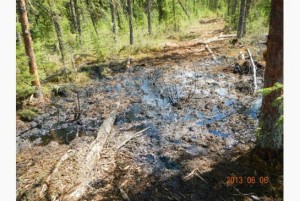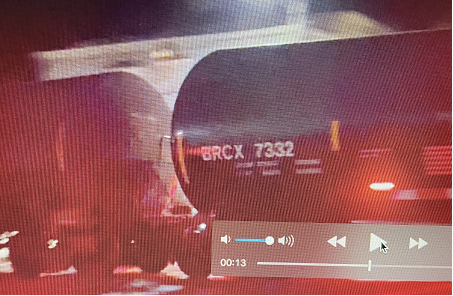Feds Sue Exxon for Polluting PA Drinking Water with Toxic Fracking Waste
July 26, 2013Internal EPA Report Highlights Disputes Over Fracking and Well Water
July 29, 2013By Chris Tackett, treehugger.com, July 24, 2013
 As if ruptured pipelines, train explosions and drilling rig fires weren’t enough ways for oil to damage the environment, oil companies are now creating new types of disasters.
As if ruptured pipelines, train explosions and drilling rig fires weren’t enough ways for oil to damage the environment, oil companies are now creating new types of disasters.
For at least six weeks, thousands of barrels of tar sands oil have been bubbling up into the forest in Cold Lake, Alberta and neither the oil company or government scientists know how to stop the flow.
Emma Pullman and Martin Lukacs at The Toronto Star report on the controversial extraction method that is likely the cause for the leak:
The company’s operations use an “in situ” or underground extraction technology called “cyclic steam stimulation,” which involves injecting thousands of gallons of superhot, high-pressure steam into deep underground reservoirs. This heats and liquefies the hard bitumen and creates cracks through which the bitumen flows and is then pumped to the surface.
Emma Pullman explained the process on Huffington Post:
According to CNRL’s website CSS is a three stage thermal recovery method where steam is first injected into the well at temperatures over 300°C and pressures of 10-12 Mpa (1450-1740 psi). This heats the bitumen in the reservoir, reducing the viscosity so that it can flow. The steam is then left to ‘soak’ before production begins for several weeks, mobilizing cold bitumen, and then the flow on the injection well is reversed, producing oil through the same injection well bore.
The CSS process is only able to typically recover approximately 20% of the oil in the ground.
CSS as a process is relatively new, having been developed by Shell by accident in Venezuela after one of its steam injectors blew out. The process is becoming more common in the San Joaquin Valley of California, the Lake Maracaibo area of Venezuela, and in the tar sands.
Media have not been allowed to visit the disaster site, but The Toronto Star spoke with a government scientist that has been to the site and he says the “operation was in chaos.”
“Everybody (at the company and in government) is freaking out about this,” said the scientist. “We don’t understand what happened. Nobody really understands how to stop it from leaking, or if they do they haven’t put the measures into place.”
One would think that oil companies would be responsible for having cleanup and disaster response plans ready before these disasters occur, but here we are six weeks after this oil began leaking and the company is still claiming to be working on a plan.
Making matters worse, there is no known solution:
“This is a new kind of oil spill and there is no ‘off button,’ ” said Keith Stewart, an energy analyst with Greenpeace who teaches a course on energy policy and environment at the University of Toronto. “You can’t cap it like a conventional oil well or turn off a valve on a pipeline.
“You are pressurizing the oil bed so hard that it’s no wonder that it blows out. This means that the oil will continue to leak until the well is no longer pressurized,” which means the bitumen could be seeping from the ground for months.
Thomas Stackpole at Mother Jones explains how this oil site differs from other tar sands extraction sites:
The Primrose bitumen emulsion site, where the leak occurred, sits about halfway up Alberta’s eastern border and pulls about 100,000 barrels of bitumen—a thick, heavy tar that can be refined into petroleum—out of the ground every day. But unlike the tar sand mines that have scarred the landscape of northern Alberta and added fuel to the Keystone XL controversy, the Primrose site injects millions of gallons of pressurized steam hundreds of feet into the ground to heat and loosen the heavy, viscous tar, and then pumps it out, using a process called cyclic steam stimulation (CSS). Eighty percent of the bitumen that can currently be extracted is only accessible through steam extraction. (CSS is one of a few methods of steam extraction.) Although steam extraction has been touted as more environmentally friendly, it has also been shown to release more CO2 than its savage-looking cousin.
It is worth reiterating that the “greener” method of tar sands development has resulted in an unstoppable oil leak.
When you consider that tar sands oil sinks in water, making those oil spills much, much harder to clean, plus the impact extracting and burning the Canadian tar sands will have on climate change and knowing this mess has been bubbling into an Alberta forest for six weeks and there’s no plan to stop it, the case against developing these fuels becomes stronger by the day.



